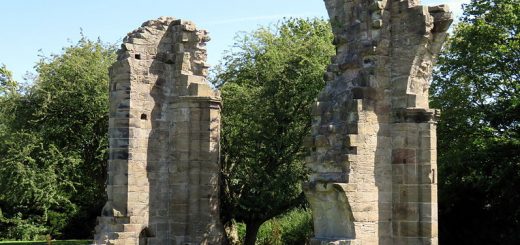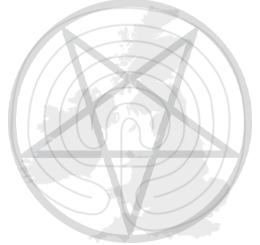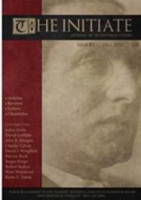Lady Eleanor Primrose And The Conjurer Of Canongate
According to John Ingram, Sir Walter Scott’s (Born 15 August 1771 – Died 21 September 1832) story ‘My Aunt Margaret’s Mirror’ was based upon events surrounding Eleanor Countess of Stair. In his book ‘The Haunted Homes and Family Traditions of Great Britain’ (1897), Ingram gives the following full account which he compiled using the work of Robert Chambers and other Scottish writers.
Lady Eleanor Campbell was youngest daughter of James, second Earl of Loudon (Died 1684), and, therefore, granddaughter to that stern old Earl who played so important a part in the affairs of the Covenant, and who was Lord Chancellor of Scotland during the Civil War. [This being John Campbell, 1st Earl of Loudoun (Born 1598 – Died 1662)]. Whilst very young, in the beginning of the last century, Lady Mary was married to James, the first Viscount Primrose [and also 3rd Baronet of Carrington]. Her husband is described as a nobleman of bad temper and dissolute habits, and is averred to have treated his young wife with great brutality. Eventually his conduct became so outrageous that the unfortunate lady went in fear of her life. One morning, it is stated, whilst she was labouring under this dreadful anticipation, she was dressing herself in her chamber, near an open window, when she saw her husband enter the room with a drawn sword in his hand. He had opened the door softly, and approached his wife with stealthy steps, but she had caught a glimpse, in the mirror, of his face, upon which his horrible resolution was depicted, and before he had time to do her any injury, she leapt through an open window into the street. She does not appear to have sustained any important injury by her dangerous leap, and was enabled, half-dressed as she was, to get to the house of her husband’s mother and claim her protection, which was, of course, accorded.
After such proceedings, it was impossible to think of a reconciliation, and, in future, the ill-assorted couple lived apart. Soon after this escapade, Lord Primrose went abroad, and for a very long while Lady Primrose heard nothing whatever about him. During this lengthy separation a foreign fortune-teller, or necromancer, came to Edinburgh, and, among other accomplishments, professed to be able to inform anyone of the present condition or position of any other person in whom the applicant was interested, irrespective of their distance. Hearing of the marvels performed by this foreigner, and incited by curiosity, Lady Primrose went, with a lady friend, to his lodgings in the Canongate for the purpose of inquiring about her absent husband.
The two ladies, escorted by their servants, duly reached the place of their quest. Lady Primrose having described the individual in whose fate she was interested, and having expressed her desire to know how he was occupied, was led by the conjuror to a large mirror. Upon looking into it, she perceived distinctly the inside of a church, within which, grouped about the altar, a marriage ceremony appeared to be proceeding. What, however, was Lady Primrose’s astonishment when, in the shadowy bridegroom, she recognised her own husband, although the bride’s face was entirely strange to her! The magical scene thus wonderfully displayed before her bewildered gaze, she described as not so much like a picture, or the delineation of the pencil, as a living, moving tableau of real life. Whilst Lady Primrose gazed, the whole ceremonial of the marriage appeared to be taking place before her. The necessary arrangements had been made; the priest appeared about to pronounce the preliminary service; he was, apparently, on the point of bidding the bride and bridegroom join hands, when, suddenly, a gentleman, whom the party seemed to have been waiting for some time, and in whom Lady Primrose recognised a brother of her own*, then abroad, entered the church, and hurried towards the bridal group. At first the aspect of this person was only that of a friend, who had been invited to the ceremony, and who had arrived late; but when he arrived near the party, the expression of his countenance suddenly altered. He stopped short; his face assumed a wrathful expression; he drew his sword and rushed at the bridegroom, who also drew his weapon. The whole scene then became quite tumultuous and indistinct, and speedily vanished away.
Upon her return home, Lady Primrose wrote out a minute account of the whole affair, and appended to her narrative the day of the month on which she had seen the mysterious vision. This account she sealed up in the presence of a witness and then deposited it in a place of security.
Eventually the absent brother returned home, and naturally went to visit his sister. Lady Primrose inquired if, in the course of his wanderings, he had happened to see or hear anything of her husband. The young man only responded that he wished never to hear that detestable person’s name mentioned. Pressed closely by his sister, however, he confessed at last that he had met Lord Primrose and under very strange circumstances. Whilst he was making a stay in Amsterdam he became acquainted with a very wealthy merchant whose only child, a beautiful girl, was the heiress of his enormous fortune. This merchant informed him that his daughter was engaged to a Scotchman of good position who had recently come to reside in Holland, and asked him, as a fellow-countryman of the bridegroom, to the forthcoming wedding. He went, but was a little late for the commencement of the ceremony, yet arrived, fortunately, just in time to prevent the marriage of the beautiful and amiable young Dutch girl to his own brother-in-law, Lord Primrose!
Lady Primrose had so far succumbed to the prevalent superstition of her time as to write down a full account of the vision she had beheld in the magic mirror, but she was so confounded and overcome when this wonderful confirmation of its truth was revealed to her that she almost fainted away. But one important fact had still to be ascertained. When did Lord Primrose’s attempted marriage take place? Her brother was fully enabled to answer this. Upon receiving his reply she took out a key, opened the drawer containing the account of her vision in the mirror, and, handing the manuscript to her brother, desired him to read it. He did so, and found that Lady Primrose’s narrative not only tallied in every important particular with the scene he had taken part in, but, also, that it was dated on the day that her husband’s attempted nuptials were interrupted in the way he had described!
A few words about Lady Primrose’s career will not be out of place here. In 1709** her husband died, leaving her still young and beautiful. She had many good offers, but, more than dissatisfied with her experience of the married state, she formed a resolution never to remarry. Among her suitors was the famous John Dalrymple, 2nd Earl of Stair (Born 20 July 1673 – Died 9 May 1747), who for twenty years had made Edinburgh his place of residence. Lady Primrose preferred him to all her wooers, but even on his behalf could not be persuaded to relinquish the comforts of widowhood. In order to change her resolution the Earl hit upon an expedient which, as one authority remarks, “certainly marks the age as one of little delicacy.”‘ He bribed one of her servants to admit him into her dressing-room, the window of which looked out upon the High Street. At this window, when the morning was somewhat advanced, the Earl showed himself en dishabille to the passers by. The fatal effect which this exhibition threatened to have upon the lady’s reputation, induced her to accept Lord Stair for her second husband. As Countess of Stair the lady is said to have had a fairly happy life, especially after she had succeeded in weaning the Earl from over fondness for the bottle. In 1747 she was left a widow for the second time, and in November 1759, after having long exercised sway over the first coteries of the Scottish capital, died there, at a very advanced age.
*James Primrose, 3rd Baronet Carrington and 1st Viscount Primrose actually died 1706.
**Lady Eleanor had three brothers: 1) Sir James Campbell, Knight, Order of the Bath, Colonel in the Scots Greys, died in action 30 April 1745 during War of Austrian Succession. 2) Hugh Campbell, 3rd Earl of Loudoun (Died 20 November 1731 ). 3) Colonel John Campbell.























Recent Comments